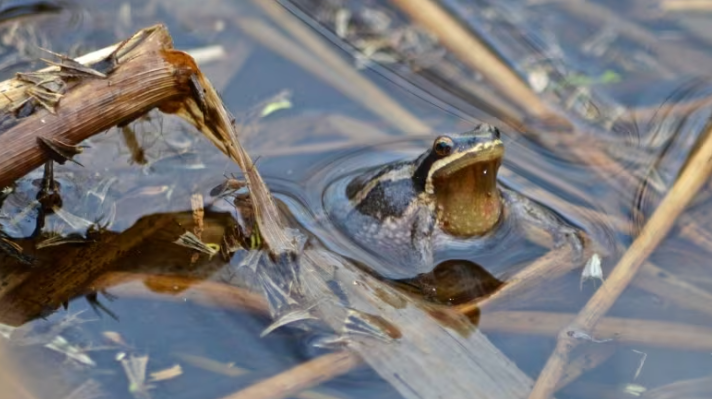How the tiny western chorus frog could stop Doug Ford’s Highway 413

Ontario has launched court challenge over federal government’s plan to conduct environmental assessment
The western chorus frog is about as small as your thumb, but it could prove to be a large obstacle to Premier Doug Ford’s plans for building Highway 413.
The chorus frog – so named because of the sound males make during mating season – is listed as threatened on Canada’s official registry of species at risk.
Consultants working for Ontario’s Ministry of Transportation have identified the frog along the 59-kilometre preferred route of the proposed Highway 413, across the northwestern fringes of the Greater Toronto Area. And while the frogs’ presence along the route may not necessarily stop the project altogether, it could force the province to change the proposed highway’s route to preserve habitat.
Building Highway 413 was one of Ford’s central promises in his 2022 re-election campaign. The PCs won every seat in Peel and York, the two regions the highway would connect.
“We’re going to make sure that we follow environmental protections that we have very vigorously put in place, but it’s our priority to build the 413,” Ontario’s Transportation Minister Prabmeet Sarkaria said during a news conference in early December.

The western chorus frog typically breeds in what are known as vernal pools: temporary ponds that form in early spring and dry up three to four months later, says David Seburn, a wildlife biologist with the Canadian Wildlife Federation.
“The reason that chorus frogs prefer these temporary ponds is they want to avoid ponds where there are fish that can eat their eggs and their tadpoles,” said Seburn in an interview.
“These ponds might be only five or 10 metres across, maybe only half a metre deep,” he said. “Typically there’s a number of ponds within close proximity to each other, and the chorus frogs might not be successful in all of those ponds in all years because some ponds may dry up too quickly.”
Habitat loss a big factor in population decline: biologist
Seburn says habitat loss is a big factor in the the decline of western chorus frog populations in Ontario.
“Many of these temporary ponds are not highly valued or thought of as being important habitats, so they’re often the first kind of habitat that gets drained and developed,” he said.
Ryan Norris, a professor in the department of integrative biology at the University of Guelph, says threatened species are typically composed of small populations found in locations that are geographically separated from each other.
“As those species have smaller populations and fewer populations, we increase the risk of extinction,” Norris said in an interview.
“In this case, we increase the risk that they disappear altogether from Ontario,” Norris said. “The more species we lose, the more our natural food webs here that we have in southern Ontario fall apart.”
The presence of the frog’s breeding grounds in Montreal’s south shore suburbs halted a housing development there in 2016 and more recently, forced changes to a road construction project.
Who controls environmental assessment could be key
A key factor in the fate of the Highway 413 project may be whether it’s the federal or provincial government that controls the environmental assessment on the project.
The environment minister in the Trudeau government, Stephen Guilbeault, has ordered the project undergo a federal impact assessment. However, the Supreme Court of Canada issued a ruling in October that the legislation behind that order exceeds the bounds of federal jurisdiction.
The Trudeau government has since indicated it will rewrite the legislation and intends to continue with its impact assessment of Highway 413. Ontario recently launched a court case to try to get the federal assessment quashed.
“We want to get shovels in the ground and I think Minister Guilbeault should respect that and the prime minister should also respect provincial jurisdiction on this matter,” Sarkaria said.
29 at-risk specifies identified along proposed route
Norris led a study commissioned by the activist group Environmental Defence that identified 29 federally listed at-risk species along the highway’s proposed route. Those species included the western chorus frog and other amphibians, as well as birds, reptiles, fish, insects and trees.
He says construction of the highway would result in water runoff, changes in water chemistry and sedimentation in streams that could affect the peripheral wetlands where the western chorus frog lives.

“Western chorus frogs are particularly sensitive to changes in the quality of their environments,” he said. “It’s got the potential to be very susceptible across a quite a wide geographic range around the highway.”
Another species that Norris says could face an even greater threat from Highway 413 than the western chorus frog is an endangered dragonfly called the rapids clubtail.
The insect has been seen in only five locations across southern Ontario over the past 25 years, one of which is the upper reaches of the Humber River between Bolton and Kleinburg, directly in the proposed path of the highway.
Related News
Trade war, slumping border traffic: What does that mean for the Gordie Howe bridge?
Amid U.S. President Donald Trump’s tariffs which have triggered a trade war with Canada, cross-border trips haveRead more
Trump administration threatens Harvard’s foreign enrolment, tax-exempt status
U.S. Homeland Security Secretary Kristi Noem speaks during an event on April 9, in Washington,Read more
